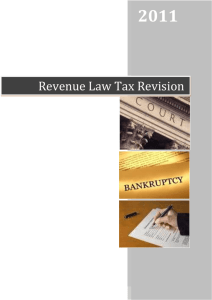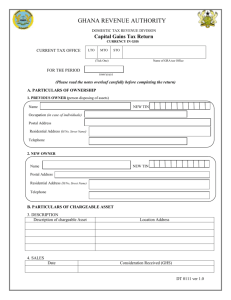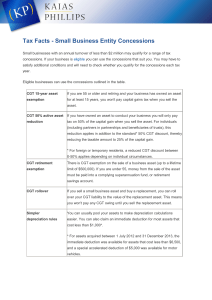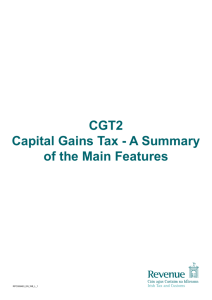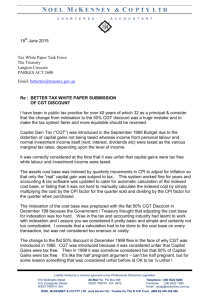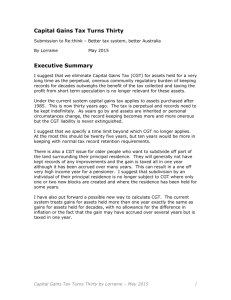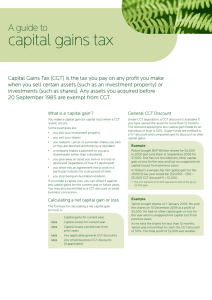Publication (PDF 156.9KB)
advertisement
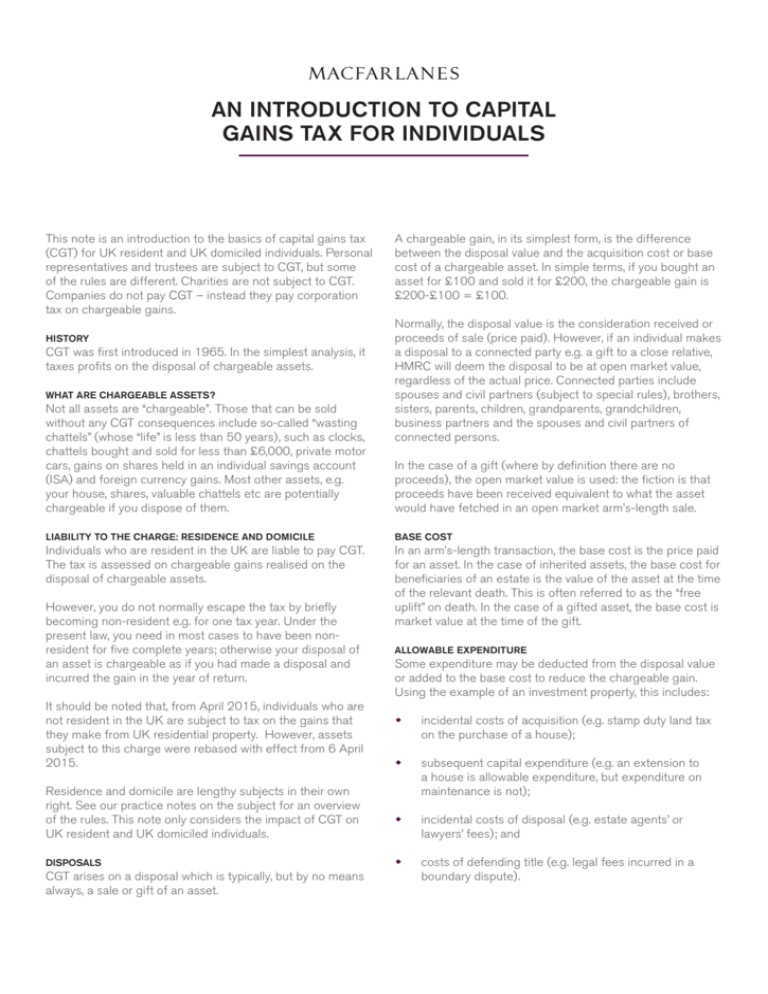
AN INTRODUCTION TO CAPITAL GAINS TAX FOR INDIVIDUALS This note is an introduction to the basics of capital gains tax (CGT) for UK resident and UK domiciled individuals. Personal representatives and trustees are subject to CGT, but some of the rules are different. Charities are not subject to CGT. Companies do not pay CGT – instead they pay corporation tax on chargeable gains. HISTORY CGT was first introduced in 1965. In the simplest analysis, it taxes profits on the disposal of chargeable assets. WHAT ARE CHARGEABLE ASSETS? Not all assets are “chargeable”. Those that can be sold without any CGT consequences include so-called “wasting chattels” (whose “life” is less than 50 years), such as clocks, chattels bought and sold for less than £6,000, private motor cars, gains on shares held in an individual savings account (ISA) and foreign currency gains. Most other assets, e.g. your house, shares, valuable chattels etc are potentially chargeable if you dispose of them. A chargeable gain, in its simplest form, is the difference between the disposal value and the acquisition cost or base cost of a chargeable asset. In simple terms, if you bought an asset for £100 and sold it for £200, the chargeable gain is £200-£100 = £100. Normally, the disposal value is the consideration received or proceeds of sale (price paid). However, if an individual makes a disposal to a connected party e.g. a gift to a close relative, HMRC will deem the disposal to be at open market value, regardless of the actual price. Connected parties include spouses and civil partners (subject to special rules), brothers, sisters, parents, children, grandparents, grandchildren, business partners and the spouses and civil partners of connected persons. In the case of a gift (where by definition there are no proceeds), the open market value is used: the fiction is that proceeds have been received equivalent to what the asset would have fetched in an open market arm’s-length sale. LIABILITY TO THE CHARGE: RESIDENCE AND DOMICILE BASE COST Individuals who are resident in the UK are liable to pay CGT. The tax is assessed on chargeable gains realised on the disposal of chargeable assets. In an arm’s-length transaction, the base cost is the price paid for an asset. In the case of inherited assets, the base cost for beneficiaries of an estate is the value of the asset at the time of the relevant death. This is often referred to as the “free uplift” on death. In the case of a gifted asset, the base cost is market value at the time of the gift. However, you do not normally escape the tax by briefly becoming non-resident e.g. for one tax year. Under the present law, you need in most cases to have been nonresident for five complete years; otherwise your disposal of an asset is chargeable as if you had made a disposal and incurred the gain in the year of return. It should be noted that, from April 2015, individuals who are not resident in the UK are subject to tax on the gains that they make from UK residential property. However, assets subject to this charge were rebased with effect from 6 April 2015. Residence and domicile are lengthy subjects in their own right. See our practice notes on the subject for an overview of the rules. This note only considers the impact of CGT on UK resident and UK domiciled individuals. DISPOSALS CGT arises on a disposal which is typically, but by no means always, a sale or gift of an asset. ALLOWABLE EXPENDITURE Some expenditure may be deducted from the disposal value or added to the base cost to reduce the chargeable gain. Using the example of an investment property, this includes: incidental costs of acquisition (e.g. stamp duty land tax on the purchase of a house); subsequent capital expenditure (e.g. an extension to a house is allowable expenditure, but expenditure on maintenance is not); incidental costs of disposal (e.g. estate agents’ or lawyers’ fees); and costs of defending title (e.g. legal fees incurred in a boundary dispute). In 1998, taper relief was introduced which applied differently to business assets and non-business assets. In essence, the longer you held an asset, the smaller the percentage of the gain which was chargeable. This was a very valuable relief – in the case of business assets, you could effectively pay a CGT rate of 10 per cent on a gain after holding the asset for only two years. EXEMPTIONS Gifts to a charity are a non-chargeable disposal and can be a highly effective form of planning where a donation is envisaged, as income tax relief may also be available. Each UK resident individual has an annual exempt amount of capital gains, which they may make without incurring tax. In 2015/2016 the amount is £11,100. Taper relief was abolished for gains accruing, or treated as accruing, from 6 April 2008. This was very unpopular with individuals planning to realise business gains, and a new entrepreneur’s relief was introduced in response to this criticism. From 6 April 2011, every individual has a lifetime allowance of £10m of gains from the disposal of qualifying business assets, which will be taxed at an effective rate of only 10 per cent. The benefit of this exemption cannot be carried forward to future tax years if it is not fully utilised in the current tax year. The exemption may be denied if you are non-domiciled and claiming to use the remittance basis. One of the most important exemptions is principal private residence (PPR) relief. Every unmarried individual or each married couple or civil partnership is allowed to have one PPR at any time. If they have more than one residence, they are entitled to make an election to determine which is their PPR (although there are restrictions on this if the relevant individual is not resident in the same country as the property or has not spent sufficient time in the property for the relevant tax year). No CGT is payable on the sale of a PPR (which can include the garden and/or grounds of the property if HMRC consider these to be necessary for the “reasonable enjoyment of the dwelling house”). Roll-over relief can be claimed in some circumstances and operates to defer the payment of CGT where the proceeds of a sale are re-invested in a new asset or a gift is made. Capital losses are offset against capital gains in the year that they arise. If allowable losses exceed chargeable gains, they can be carried forward to set against gains in future years and thus reduce tax payable. TAX RATES AND COLLECTION Transfers between spouses and civil partners are made on a no gain no loss basis and the donee effectively steps into the donor’s shoes, taking over their base cost and acquisition date. It may be advantageous to transfer assets between spouses prior to disposal in order to fully utilise both spouses’ annual exempt amounts. The rate of CGT that applies to an individual on the disposal of a chargeable asset depends on his taxable income in the year in question. In the 2015/2016 tax year, for those with a taxable income of £31,785 or less, CGT will be charged at a rate of 18 per cent (subject to any relevant exemptions or reliefs) on the amount of any chargeable gains that fall within their remaining basic rate income tax band. Any gains in excess of their basic rate income tax band will be subject to CGT at a rate of 28 per cent. Problems can occur in the case of a divorce as this treatment only applies up to the end of the tax year of separation. It can take far longer for divorce settlements to be agreed and transfers after this year will be subject to CGT. There is widespread recognition that this can create problems, but there are no current proposals to change the law, despite pressure by the Law Society and family lawyers. For those with a taxable income in excess of £31,785, CGT will be charged at 28 per cent (again, subject to any relevant exemptions or reliefs). HMRC collects CGT through the self-assessment system and usually CGT is payable on or before 31 January following the tax year of disposal: if you incur your gain in the 2015/2016 tax year, the tax is due at the latest by 31 January 2016. RELIEFS In the past, the legislation has recognised that taxpayers should not have to pay CGT on the inflation element of gains. Until 1998, there was a system of indexation. An indexation allowance (by reference to the retail prices index) was applied to remove the inflation element of a gain. 2 It follows from a cash flow perspective that it is most advantageous to make large gains immediately after the start of the tax year. Tax on a gain realised on 6 April 2015 would not be due until 31 January 2017, while if the gain had been realised one day earlier (5 April 2015), tax would have been due on 31 January 2016 (one year earlier). CONTACT DETAILS If you would like further information or specific advice please contact: EDWARD REED PARTNER PRIVATE CLIENT DD: +44 (0)20 7849 2568 edward.reed@macfarlanes.com NOVEMBER 2015 EXAMPLE In June 2014, Johnny, who has a taxable income of £25,000, sells his Rembrandt painting which he bought for £100,000 in 2000. This is the only chargeable asset that he disposes of in the tax year 2014/2015. It has proven to be a good investment and has sold for £300,000. Fees and incidental costs of sale have amounted to £20,000. His gain is therefore £180,000. The first £11,000 of the gain falls within Johnny’s annual exempt amount and as he has taxable income of £25,000, the next £6,865 of the gain will be subject to CGT at a rate of 18 per cent. The remainder of the gain will be taxed at 28 per cent. Therefore tax of £46,633.50 will be due on 31 January 2016. Gross proceeds Less incidental costs of sale Net sale proceeds Less cost Gain Less annual exemption Taxable gain Tax @ 18 per cent on £6,865 Tax @ 28 per cent on the remainder Total tax due £ 300,000 (20,000) 280,000 (100,000) 180,000 (11,000) 169,000 1,235.70 45,397.80 46,633.50 MACFARLANES LLP 20 CURSITOR STREET LONDON EC4A 1LT T: +44 (0)20 7831 9222 F: +44 (0)20 7831 9607 DX 138 Chancery Lane www.macfarlanes.com This note is intended to provide general information about some recent and anticipated developments which may be of interest. It is not intended to be comprehensive nor to provide any specific legal advice and should not be acted or relied upon as doing so. Professional advice appropriate to the specific situation should always be obtained. Macfarlanes LLP is a limited liability partnership registered in England with number OC334406. Its registered office and principal place of business are at 20 Cursitor Street, London EC4A 1LT. The firm is not authorised under the Financial Services and Markets Act 2000, but is able in certain circumstances to offer a limited range of investment services to clients because it is authorised and regulated by the Solicitors Regulation Authority. It can provide these investment services if they are an incidental part of the professional services it has been engaged to provide. © Macfarlanes November 2015
